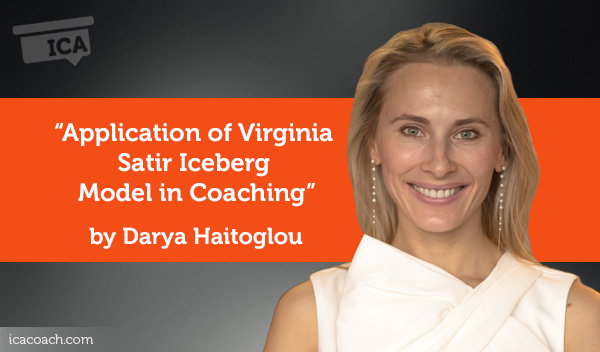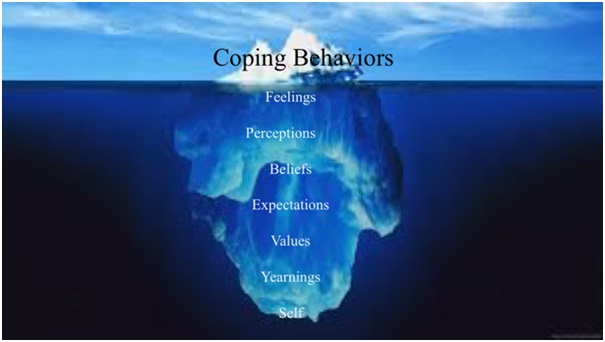
Research Paper By Darya Haitoglou
(Systemic Relationship Coaching, UNITED KINGDOM)
Virginia Satir (1916-1988) is a world-renowned communication expert who is known to be a ‘mother of family therapy’. Virginia worked with families around the world using a number of very effective tools. Iceberg Model is one of them. Whenever a communication was an issue inside family dynamics, Virginia would share this model with family members to bring their awareness to the deeper levels and structures rather than behaviours that can be observed on the surface and hence the Iceberg Model was formed.
Work of Satir inspired the creation of Neuro-Linguistic Programming and she served as one of three role-models, to become a foundation for development of this field.
Iceberg Model
Iceberg can be seen on the surface of water and this metaphor corresponds to different behaviour stances we see when people are in stress or flow.
Virginia and her colleagues talked about five coping stances or behaviours when people experience stress: blaming, placating, super-reasonable, distracting and withdrawing.
When these stances are observed, it is helpful to look deeper underneath the surface area, where they come from and understand the deeper structures that formed these behaviours and what a person needs to change them.
The deeper structures are the feelings, feelings about feelings, perceptions, beliefs, expectations, values, yearnings and the sense of Self.

Let’s look into the components of the Iceberg Model:
A blaming stance is often associated with feelings of anger and frustration. Feeling angry is a negative feeling in many cultures and hence, is not ‘welcomed’ in the person. As a consequence, they may feel bad about feeling angry.
On a level of perceptions a person could perceive someone else’s behaviour as threatening when they use a loud voice like shouting.
On a level of beliefs, a person could believe that when people shout, that is a form of an attack and hence a protection is needed.
On a level of expectations, a person may expect to be respected and talked to in a calm voice.
On a level of values, one of the values of a person could be harmony or peace. And behaviour of calm speech could be one manifestation of that.
On a level of yearnings, a person may long for being seen and accepted.
On a level of Self, a person is a manifestation of a life force and has its own intentions in life.
Application of the Iceberg Model in Coaching
When a person feels stuck or has strong negative emotions regarding certain behaviours of people around them, the Iceberg Model provides an effective tool to resolve and move towards the feeling of flow.
Let’s take an example of an application of this model to a coaching conversation.
A coachee brings an issue of a blaming behaviour of their boss towards them causing the coachee to blame someone else. During the discovery session the coachee expresses that they want to change their own blaming behaviour but they can’t seem to be able to do that.
Coach: If you allow, we can explore this using a framework called ‘Icerberg’ where the behaviour is what people see on the surface of water and below we have feelings, perceptions, beliefs, expectations, values and yearnings.
So let me ask you a few questions in relation to the blaming behaviour that you want to change.
How do you feel when you blame another person?
Coachee: I feel angry and frustrated.
Coach: And how do you feel about feeling angry?
Coachee: I feel sad. I feel bad about it.
Coach: So you feel sad about feeling angry. What makes you feel angry?
Coachee: When I see someone’s accusing me for something I haven’t done or what I deem not fair.
Coach: What is is about fairness that is important to you?
Coachee: I believe it’s important to have a fair attitude to people. Fairness is something I try to have in my life and I apply this principle to other people.
Coach: So you want other people to be fair to you. And you want to be treated fairly. What is a deeper longing behind that you think?
Coachee: (Pause) I think there is a longing for harmony and justice. It’s been an important part of my life.
Coach: What is the best belief that can help meet the need for harmony and justice?
Coachee: (Pause) Whatever people say or do, harmony is much more important as it allows for loving-kindness.
People know themselves if they are not fair. Giving them information and sharing alternative perspectives, and giving them space to make their own decisions.
Coach: How would you feel about this?
Coachee: Good. It would give me strength. I wouldn’t need to protect myself as much.
Coach: Good. What about if someone still behaves unfairly or disrespectfully, what is the best response, if harmony is the need?
Coachee: Just explain additional information without making it personal.
Coach: How would that make you feel?
Coachee: Great. I think I got it. I used to make it personal but I don’t need to. I can just share the same information and without blaming others, or feeling bad. I can still keep harmony and justice. Thank you.
Here is a list of questions using ‘Satir Iceberg Model” in coaching conversations.
References
Satir, Virginia, et. al., The Satir Model: Family Therapy and Beyond, ISBN 0831400781, Science and Behavior Books, 1991.